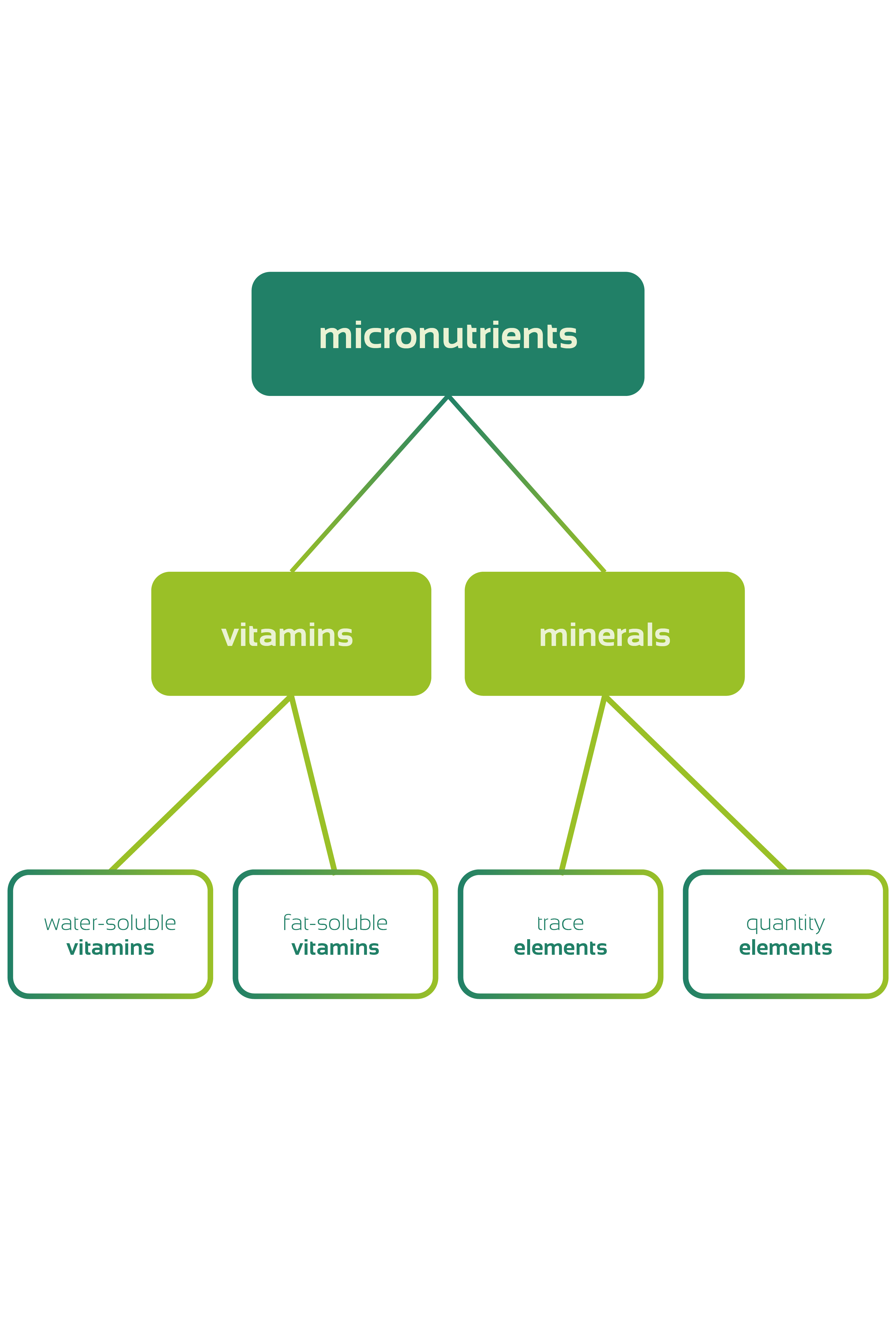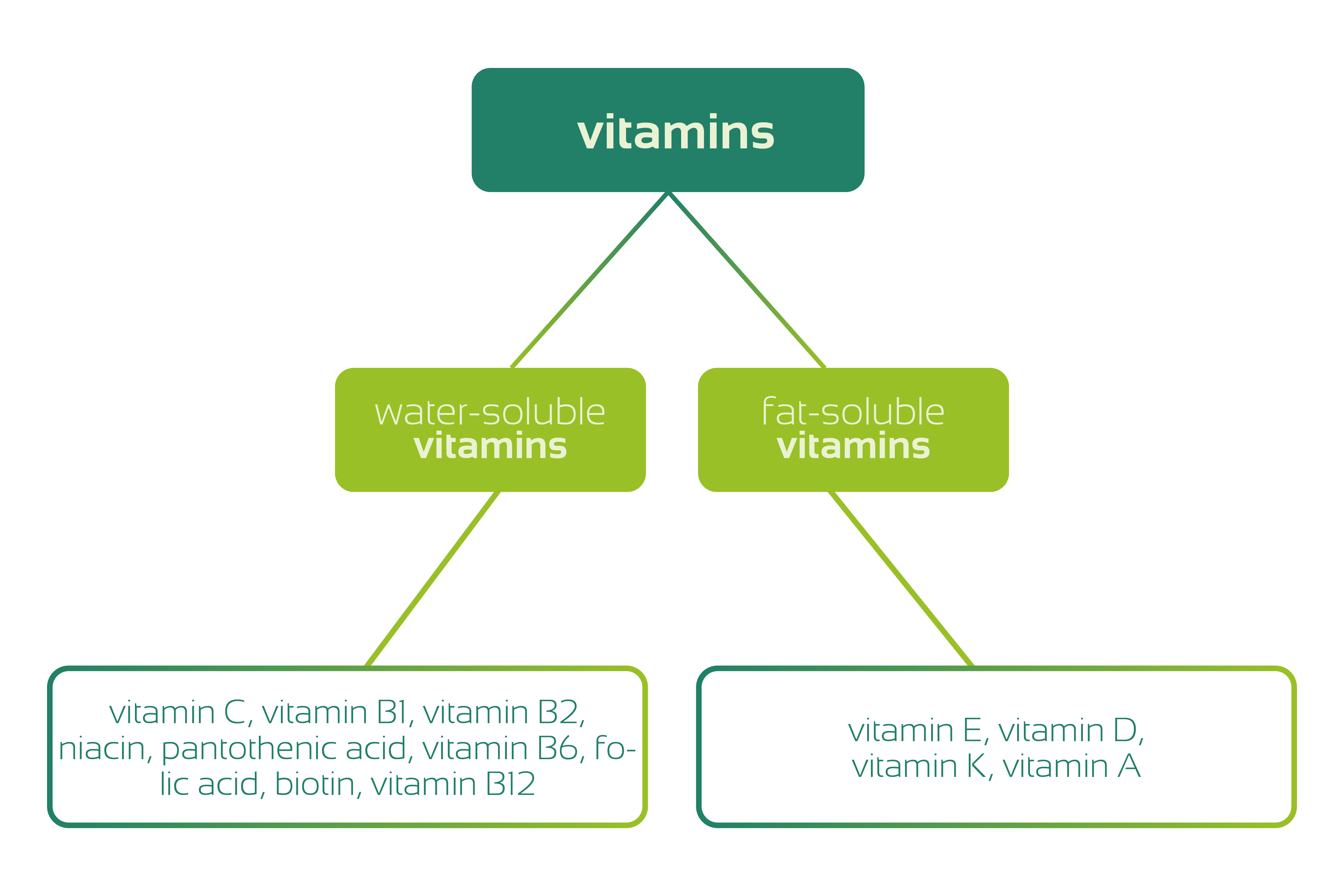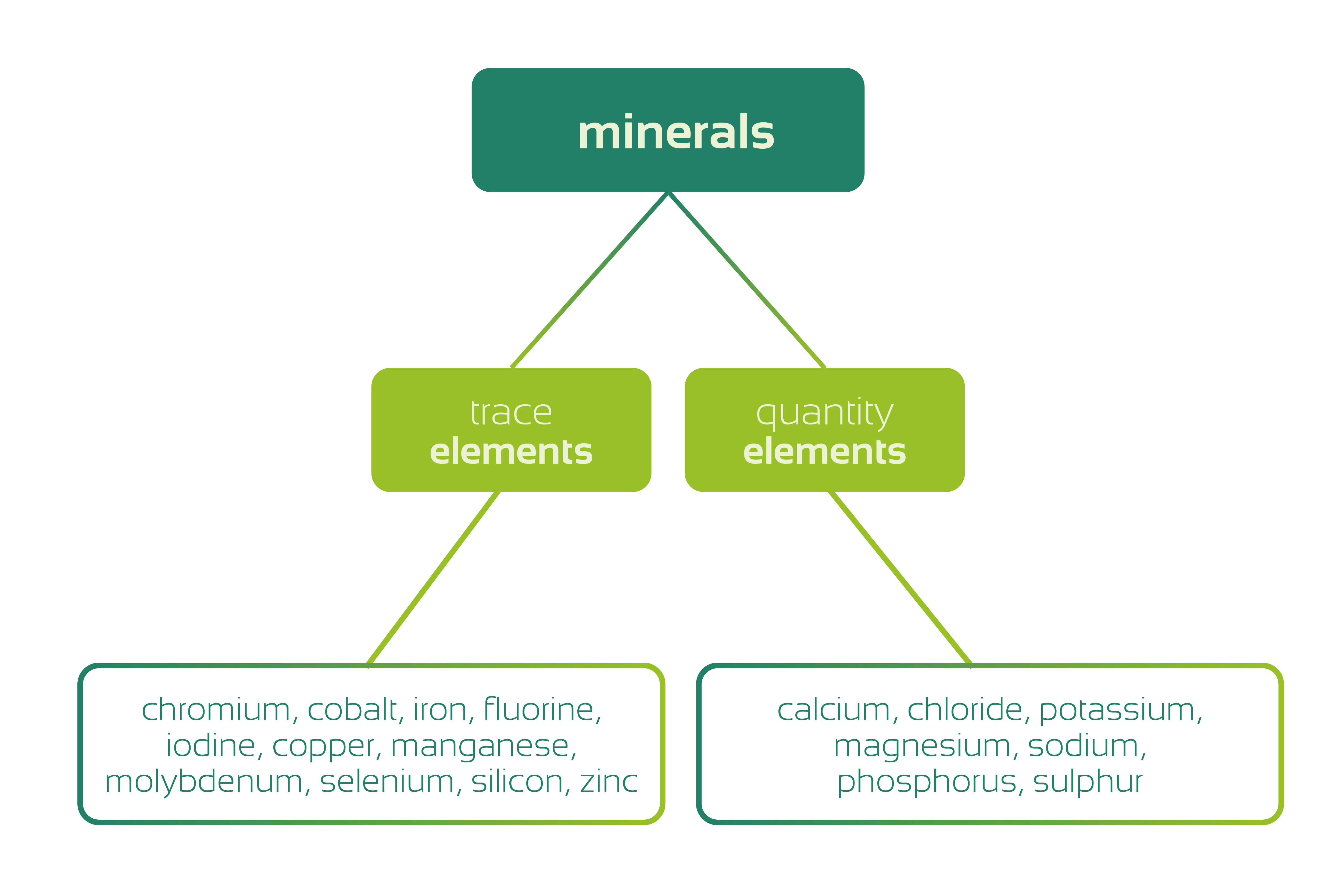Ingredients |

Classification of micronutrients
Micronutrients include vitamins and minerals. Minerals can be divided into bulk and trace elements, vitamins into fat-soluble and water-soluble vitamins.
Micronutrients are involved in numerous vital bodily functions, including ensuring growth, child development and survival. For example, vitamins and minerals play a major role in energy metabolism, i.e. they help the body to obtain energy from macronutrients in order to maintain cell and organ functions. Micronutrients such as vitamin A or zinc are also important for the immune system.
Individual micronutrients perform specific tasks and therefore cannot be replaced by any other compound. For example, the mineral magnesium plays an important role for muscles and vitamin C supports the immune system. A deficiency of one of these nutrients can have serious consequences for health, leading to illness or even death. Other micronutrients, such as water-soluble vitamins, can replace each other in their effects - vitamin C, for example, acts as a radical scavenger, as does vitamin E.
In addition to the classification of vitamins and minerals, micronutrients can be categorized according to their mode of action. Compounds
- which act as cofactors in the metabolism,
- substances that have a hormone-like effect or perform important tasks as part of a hormone and
- antioxidants that act as radical scavengers
are distinguished.
The daily requirement of vitamins and minerals differs from micronutrient to micronutrient and covers a wide range from 2.5 µg (vitamin B12) to 2000 mg (potassium). Compared to the macronutrients, of which a total of more than 500 g should be consumed daily, the daily requirement of vitamins and minerals is very low. Some micronutrients are only broken down slowly or stored in the body, so that a daily intake is not necessary for all of them.

The vitamins
Vitamins are chemically diverse, organic compounds that are essential for maintaining basic bodily functions and health in the human or animal body. The word vitamins (vita-amine) means amines (nitrogen compounds) of life and has its origin in the fact that some of them contain nitrogen. They are essential nutrients because, with two exceptions, they cannot be produced by the body itself. Vitamins must therefore be taken in with food. They can come from both plant and animal foods.
Classification of vitamins
Vitamins fulfill a wide variety of functions in the body. For example, they are involved in the metabolism in the utilization of carbohydrates, fats and proteins. Vitamins also play a role in the formation of blood cells, bones and teeth, some have a hormone-like effect and protect against oxidative damage. The human requirement for the various compounds is very low. For the special biochemical effects, only the smallest amounts in the range of traces are necessary. At the same time, the exact amount required depends on various factors and is therefore individual for each person.
Vitamins can be divided into different functional groups according to their functions. However, this classification is not always clear-cut, as most vitamins fulfill different functions and would therefore belong to several groups. It is therefore common to divide vitamins into fat-soluble and water-soluble groups, as this classification allows a clear allocation. The "EDKA" vitamins A, D, E and K form the group of fat-soluble vitamins.
Vitamin C and the eight vitamins of the B complex form the group of water-soluble vitamins. An additional common feature of these substances is their effect as coenzymes. According to the water- and fat-soluble properties of the two groups, the associated vitamins differ in terms of occurrence, storage and transport. The water-soluble vitamins are only slightly stored by the body and can be easily excreted via the urine in the event of an overdose. In contrast, fat-soluble vitamins accumulate in fatty tissue and are stored there.
This can result in so-called hypervitaminosis. If vitamin intake is too low, on the other hand, hypovitaminosis or even avitaminosis can occur. These can be prevented by vitaminizing foods. A distinction is made between two forms - revitaminization and vitamin fortification. In revitaminization, the vitamin content of foods (e.g. low-milled flour) is increased to the original vitamin content of the raw material (the whole grain). In vitamin fortification, high doses of vitamins are added to juices or soft drinks, for example.
Vitamin loss
Acid, alkali, oxygen, daylight, UV light and heat can lead to vitamin loss. The parameters acid and alkali are hardly relevant in practice, but oxygen, light (both daylight and UV light) and heat are all the more relevant.
During the manufacture of products containing vitamins, or at the latest during storage, they come into contact with at least one of these parameters, and usually all of them at the same time. Correct handling and storage of food is therefore particularly important in order to avoid excessive vitamin loss. This is why the words "Store in a cool, dry and dark place" are often printed on labels to prevent vitamin loss due to improper storage by the consumer.
Under the influence of oxygen, vitamins begin to oxidize, which slowly destroys them. The loss of vitamins through oxygen is difficult to stop in everyday life. Certain vitamins can also be degraded if they are exposed to light over a longer period of time. For some vitamins such as A or E, daylight is sufficient, while other vitamins such as B1 are only destroyed by UV light. Storage protected from light, such as in opaque plastic packaging or dark glass, can prevent or at least slow down this process.
Heat is also a danger for many vitamins. Losses due to heat can occur, for example, as a result of heat exposure during food production, long storage in a warm place or heating during food preparation. For powders that are prepared with hot water, it is therefore advisable to overdose the vitamins to compensate for the losses.

The minerals
The term minerals describes all inorganic components of the human organism that are vital for our body. Minerals can be absorbed as inorganic salts, such as sodium chloride, or in organically bound form. Iron is very often found as a component of organic complexes, for example as the central atom of haemoglobin. The various minerals and their complexes are found in plant and animal foods.
Classification of minerals into bulk and trace elements
Minerals fulfill important and diverse tasks in the body. They regulate the metabolism and are responsible for the formation of scaffolding and supporting substances. In addition to building cells, bones, muscles and teeth, they also maintain their function and contribute to the stability of the human body. They also play a major role in the electrolyte and hydrogen balance and the maintenance of electrolytic and osmotic equilibrium. Other important tasks of minerals include controlling enzyme reactions and influencing nerve activity. They are essential for the maintenance of the human body.
Minerals can be divided into bulk elements and trace elements, depending on their requirements and occurrence in the human body. They are categorized according to the daily amount required by the body or the total body stock. Bulk elements are required by the average adult in quantities of over 100 mg per day, with their total content in the body being more than 50 mg per kilogram of body weight. In line with the higher requirement, bulk elements are also contained in food in larger quantities. Trace elements, on the other hand, require less than 100 mg per day and make up less than 50 mg per kilogram of body weight. In turn, they are only found in smaller quantities in foods.
In terms of total body content, iron lies exactly on the borderline between bulk and trace elements and is usually counted as a trace element in the literature.
The daily mineral requirement is individual for each mineral and depends on various factors such as lifestyle.
In food supplements, minerals are often used in capsules and isotonic drinks. These drinks have the same mineral content as human blood and therefore give the drink a blood-like character. This allows the minerals to be absorbed more quickly by the body.


